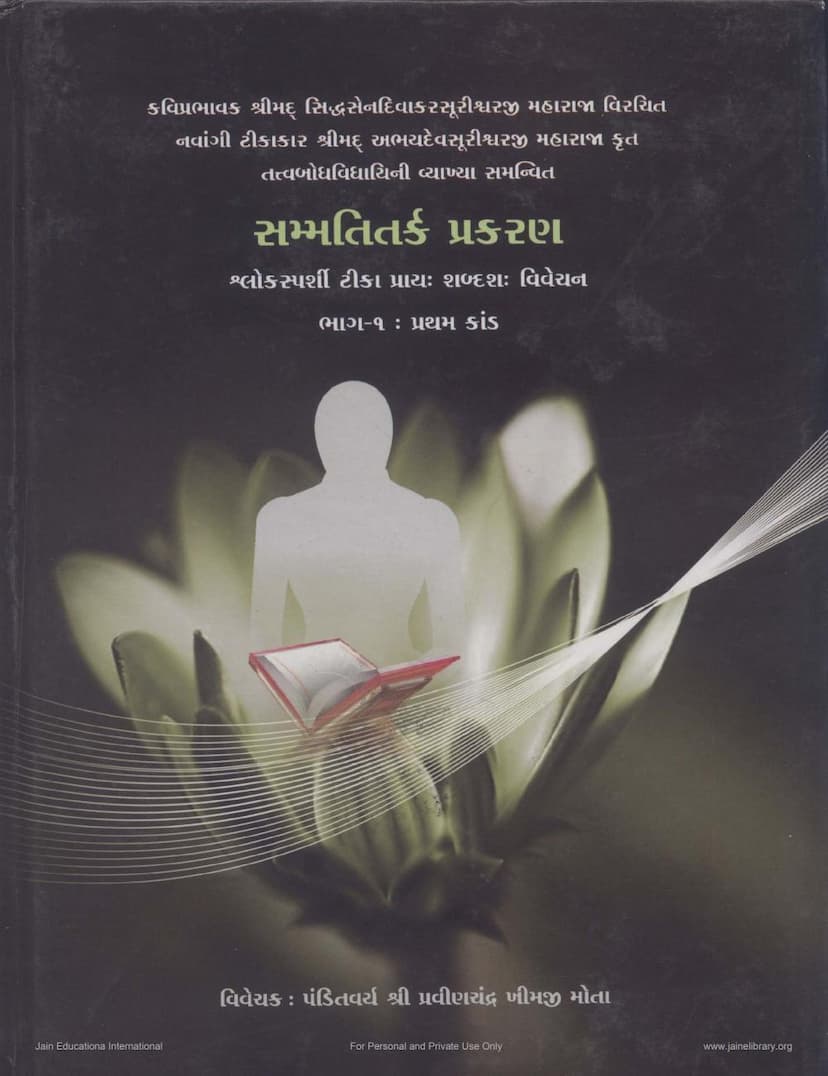Sammati Tark Prakaran Part 01
Added to library: September 2, 2025

Summary
Here's a comprehensive summary of the provided Jain text, "Sammati Tark Prakaran Part 01," based on the text you've shared:
Book Title: Sammati Tark Prakaran Part 01 Author: Pravinchandra K Mota Publisher: Gitarth Ganga Commentary: Tatva Bodh Vidhayini by Shrimad Abhaydevsurishwarji Maharaj Original Author: Shrutkevali Shrimad Siddhsena Divakarsurishwarji Maharaj
Overall Purpose and Introduction:
The book is the first part of the "Sammati Tark Prakaran," a foundational Jain text authored by the esteemed Shrutkevali Shrimad Siddhsena Divakarsurishwarji Maharaj, with commentary by Shrimad Abhaydevsurishwarji Maharaj. The title "Sammati" itself signifies "pure intellect for seeing substances realistically." The text aims to equip readers with this pure intellect through logical reasoning ("Tark") to understand the true nature of reality.
The introduction highlights that while Jinendra's words are the ultimate proof for understanding transcendental substances, the "Sammati Tark Prakaran" provides the pure vision needed to comprehend these words accurately. It emphasizes that mere attainment of Jinashasan (Jainism) is not enough; deep understanding of its profound secrets and unwavering devotion are necessary for true liberation. The "Gitarth Ganga" institution, through its work, aims to reveal these secrets by compiling and reconciling scattered scriptural statements, resolving apparent contradictions, and making them accessible through explanations.
Core Concepts and Structure (Based on the provided pages):
The initial part (Part 01, First Chapter - "Pratham Kand") focuses on establishing the fundamental principles of Jain logic and epistemology, primarily through the concepts of Nayas (viewpoints or standpoints).
-
The Nature of Knowledge and Reality:
- The text begins by establishing that the soul (Jiva) and matter (Pudgal) are the fundamental substances perceived by all beings.
- It introduces the concept of two primary Nayas:
- Dravyastik Naya: This viewpoint focuses on the general essence or the underlying substance (Dravya) that persists through changes. It sees commonality and permanence.
- Prayayastik Naya: This viewpoint focuses on the specific characteristics or the modes and modifications (Prayay) that are transient and distinct. It emphasizes difference and change.
- The book asserts that true understanding of reality comes from grasping both Dravyastik and Prayayastik Nayas, as they are not contradictory but complementary.
-
The Six Nayas and Their Interrelation:
- The text elaborates on the origin and function of the six Nayas (Sanggrah, Vyavahar, Rujusutra, Shabd, Samabhirudh, Evambhut).
- It explains how Sanggrah Naya focuses on the general essence (dravya), while Vyavahar and Rujusutra Nayas deal with the specific characteristics (prayay) in practical application and the present moment, respectively.
- Shabd, Samabhirudh, and Evambhut Nayas are described as subtler analyses of prayay, differentiating based on linguistic conventions, the inherent meaning of words, and the actual action performed.
- It stresses that each Naya, when considered in isolation, can lead to one-sided (ekant) or incorrect views. True understanding arises when these Nayas are seen in their mutual interdependence (Paraspar Saapeksh).
-
Syadvada and Sapta-bhangi:
- The text highlights that Syadvada (the doctrine of manifold predications) is the foundation of correct understanding and the seed of right faith (Samyak Darshan).
- The Sapta-bhangi (seven-fold predication) is introduced as a crucial tool derived from the Nayas for understanding the multifaceted nature of reality. The book explains how the sevenfold predication arises from the interplay of Nayas, particularly the Arth Naya (meaning-based viewpoint) and Vyanjan Naya (sound/word-based viewpoint).
-
Critique of Ekantavada (One-sided Views):
- A significant portion of the introduction and early chapters is dedicated to refuting one-sided viewpoints. The text uses examples from other philosophical schools (like Sankhya, Bauddha, Vaisheshika, Advaita) to illustrate how their exclusive reliance on a single aspect leads to flawed conclusions about reality, karma, and liberation.
- It critiques the idea of an eternal, unchanging soul (Dravya without Prayay) or a completely momentary existence (Prayay without Dravya) as incomplete and ultimately leading to misunderstanding.
-
The Role of the Author and Publisher:
- The publication is presented as a labor of love by "Gitarth Ganga," a trust dedicated to spreading Jain knowledge.
- The author, Pravinchandra K Mota, is a scholar (Pandit Varya) who has meticulously analyzed the original text and its commentaries.
- The publication is supported by generous donations, indicating a community effort.
Key Arguments Presented:
- Mutual Interdependence of Nayas: The text argues that no single Naya is absolutely correct in isolation. True knowledge comes from understanding how they interrelate and complement each other.
- Refutation of Ekantavada: The book systematically dismantles one-sided views, showing how they fail to account for the complexity of reality, which is characterized by both permanence (Dravya) and change (Prayay).
- Syadvada as the Path to Truth: The doctrine of Syadvada, which allows for multiple viewpoints and the acceptance of contradictions through the lens of Nayas, is presented as the only valid path to understanding reality and achieving spiritual progress.
- The Importance of Both Theory and Practice: While the text delves into philosophical and logical arguments, the introductory and concluding remarks emphasize the need for devotion and spiritual practice alongside knowledge for true spiritual benefit.
In essence, "Sammati Tark Prakaran Part 01" aims to be a rigorous philosophical treatise that provides the intellectual framework for understanding Jain metaphysics and epistemology. It meticulously lays out the logic of Nayas and Syadvada, demonstrating their necessity for overcoming one-sided philosophical views and attaining a correct perception of reality.